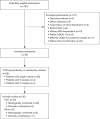IDEAL-IQ measurement can distinguish dysplastic nodule from early hepatocellular carcinoma: a case-control study
- PMID: 38846285
- PMCID: PMC11151266
- DOI: 10.21037/qims-23-1593
IDEAL-IQ measurement can distinguish dysplastic nodule from early hepatocellular carcinoma: a case-control study
Abstract
Background: Previous studies have confirmed that malignant transformation of dysplastic nodule (DN) into hepatocellular carcinoma (HCC) is accompanied by reduction of iron content in nodules. This pathological abnormality can serve as the basis for magnetic resonance imaging (MRI). This study was designed to identify the feasibility of iterative decomposition of water and fat with echo asymmetry and least squares estimation-iron quantitative (IDEAL-IQ) measurement to distinguish early hepatocellular carcinoma (eHCC) from DN.
Methods: We reviewed MRI studies of 35 eHCC and 23 DN lesions (46 participants with 58 lesions total, 37 males, 9 females, 31-80 years old). The exams include IDEAL-IQ sequence and 3.0T MR conventional scan [including T1-weighted imaging (T1WI), T2-weighted imaging (T2WI), diffusion-weighted imaging (DWI), and Gadopentic acid (Gd-GDPA)-enhanced]. Then, 3 readers independently diagnosed eHCC, DN, or were unable to distinguish eHCC from DN using conventional MRI (CMRI), and then assessed R2* value of nodules [R2* value represents the nodule iron content (NIC)] and R2* value of liver background [R2* value represents the liver background iron content (LBIC)] with IDEAL-IQ. Statistical analysis was conducted using the t-test for comparison of means, the Mann-Whitney test for comparison of medians, the chi-square test for comparison of frequencies, and diagnostic efficacy was evaluated by using receiver operating characteristic (ROC) curve.
Results: This study evaluated 35 eHCC participants (17 males, 6 females, 34-81 years old, nodule size: 10.5-27.6 mm, median 18.0 mm) and 23 DN participants (20 males, 3 females, 31-76 years old, nodule size: 16.30±4.095 mm). The NIC and ratio of NIC to LIBC (NIC/LBIC) of the eHCC group (35.926±12.806 sec-1, 0.327±0.107) was lower than that of the DN group (176.635±87.686 sec-1, 1.799±0.629) (P<0.001). Using NIC and NIC/LBIC to distinguish eHCC from DN, the true positive/false positive rates were 91.3%/94.3% and 87.0%/97.1%, respectively. The rates of CMRI, NIC and NIC/LBIC in diagnosis of eHCC were 77.1%, and 94.3%, 97.1%, respectively, and those of DN were 65.2%, 91.3%, and 87.0%, respectively. The diagnosis rate of eHCC and DN by CMRI was lower than that of NIC and NIC/LBIC (eHCC: P=0.03, 0.04, DN: P=0.02, 0.04).
Conclusions: Using IDEAL-IQ measurement can distinguish DN from eHCC.
Keywords: Early hepatocellular carcinoma (eHCC); dysplastic nodule (DN); iterative decomposition of water and fat with echo asymmetry and least squares estimation-iron quantitative (IDEAL-IQ); magnetic resonance imaging (MRI).
2024 Quantitative Imaging in Medicine and Surgery. All rights reserved.
Conflict of interest statement
Conflicts of Interest: All authors have completed the ICMJE uniform disclosure form (available at https://qims.amegroups.com/article/view/10.21037/qims-23-1593/coif). All authors report that this study received funding from Shenzhen High-level Hospital Construction Fund (No. G2022108). The authors have no other conflicts of interest to declare.
Figures





Similar articles
-
Contribution of diffusion-weighted magnetic resonance imaging in the characterization of hepatocellular carcinomas and dysplastic nodules in cirrhotic liver.J Comput Assist Tomogr. 2010 Jul;34(4):506-12. doi: 10.1097/RCT.0b013e3181da3671. J Comput Assist Tomogr. 2010. PMID: 20657216
-
Evaluation of Glypican-3 Expression in Hepatocellular Carcinoma by Using IDEAL IQ Magnetic Resonance Imaging.Acad Radiol. 2021 Aug;28(8):e227-e234. doi: 10.1016/j.acra.2020.05.015. Epub 2020 Jun 12. Acad Radiol. 2021. PMID: 32540197
-
[Dysplastic nodule of liver versus early hepatocellular carcinoma: a clinicopathologic and prognostic study].Zhonghua Bing Li Xue Za Zhi. 2014 May;43(5):301-6. Zhonghua Bing Li Xue Za Zhi. 2014. PMID: 25030861 Chinese.
-
Current Concepts of Precancerous Lesions of Hepatocellular Carcinoma: Recent Progress in Diagnosis.Diagnostics (Basel). 2023 Mar 23;13(7):1211. doi: 10.3390/diagnostics13071211. Diagnostics (Basel). 2023. PMID: 37046429 Free PMC article. Review.
-
Benign versus malignant hepatic nodules: MR imaging findings with pathologic correlation.Radiographics. 2002 Sep-Oct;22(5):1023-36; discussion 1037-9. doi: 10.1148/radiographics.22.5.g02se061023. Radiographics. 2002. PMID: 12235331 Review.
Cited by
-
An overview of risk assessment and monitoring of malignant transformation in cirrhotic nodules.Therap Adv Gastroenterol. 2024 Oct 27;17:17562848241293019. doi: 10.1177/17562848241293019. eCollection 2024. Therap Adv Gastroenterol. 2024. PMID: 39493259 Free PMC article. Review.
-
Quantitative assessment of rotator cuff injuries using synthetic MRI and IDEAL-IQ imaging techniques.Heliyon. 2024 Sep 4;10(17):e37307. doi: 10.1016/j.heliyon.2024.e37307. eCollection 2024 Sep 15. Heliyon. 2024. PMID: 39296233 Free PMC article.
-
Predictive Value of IDEAL-IQ and DWI Imaging Biomarkers for P53 Mutations in Hepatocellular Carcinoma.J Hepatocell Carcinoma. 2025 Aug 6;12:1743-1753. doi: 10.2147/JHC.S524533. eCollection 2025. J Hepatocell Carcinoma. 2025. PMID: 40792053 Free PMC article.
References
LinkOut - more resources
Full Text Sources
